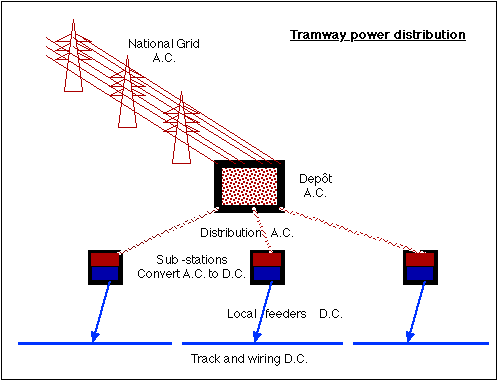
| Return to previous page |
|
When electrical energy is turned into useable power, heat, movement, light etc., it does not matter which direction the voltage and current flow, or even if that direction changes from time to time. Power can still be extracted from the energy flow.
D.C.
The earliest example of electrical supplies were those derived
from chemical batteries, which produced a unidirectional flow
- Direct Current.
A.C.
Electromagnetism is nowadays more commonly used for electricity
production, relative movement between magnets and wires or coils
generates electricity. This movement cannot continue in one direction
indefinitely and has to keep returning to its starting point,
either by moving to-and-fro like a piston in an engine (rarely
practical for electrical power generation) or by rotating around
a shaft as in the most common forms of generators. This constant
cyclical movement produces a cyclic electricity flow - Alternating Current.
A.C. can be converted into D.C. at a generator by simply arranging for the connections to the generating coils to be transposed automatically, in step with the direction of current generation, by a 'commutator', a contact arrangement on the same rotating shaft as the coils.
Another way of converting A.C. to D.C. is by means of a 'Rectifier' A device which allows current to flow one way but prevents it from flowing the other way. By having multiple coils around the alternator shaft, connected to a rectifier made from a network of one-way diodes, it is possible to arrange that, at any given moment, at least one of the coils is generating in the required direction and a substantially uniform current, without interruptions, can be obtained from the diode network . Modern car alternators work in this way, giving a D.C. output which can be used to recharge the battery (A.C. would be useless, as it would alternately charge and discharge it).
Converting from D.C. to A.C. is much more difficult. In the past a D.C. motor was coupled to an (A.C.) alternator to form a 'Rotary Converter' set. This wasted energy because it needed to be kept running even when there was no load; and was a comparatively inefficient and high maintenance piece of equipment. Modern semiconductors (transistors, thyristors, triacs, IGBTs etc.) can be used to switch the D.C. on and off in various directions of flow, so as to reconstitute A.C. The equipment to perform this switching is expensive and the control and protection gear is complex. Although cheaper to run, the high initial cost often rules out the provision of such an 'Inverter' system on economic grounds.
A.C. power in the U.K. alternates at 50 cycles per second
Nowadays the best compromise is to take A.C. from the mains electricity supply and distribute it across the tramway network. At local sub-stations near the tracks it is transformed to the correct voltage for the overhead wire (Usually 750 volts) and rectified to give D.C. at each local distribution point.

Thus the advantages of low-loss A.C. distribution
are gained but the regenerative braking
controls of the trams can still be relatively straightforward
D.C. systems.
There is an additional cost of the rectifier units at each sub-station
but this is small in comparison to the savings; and modern rectifiers
are an efficient, well-proven, trouble-free technology.
| Return to previous page |
|